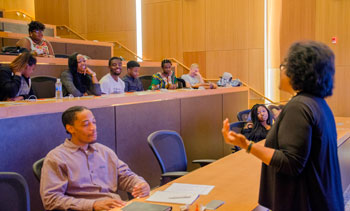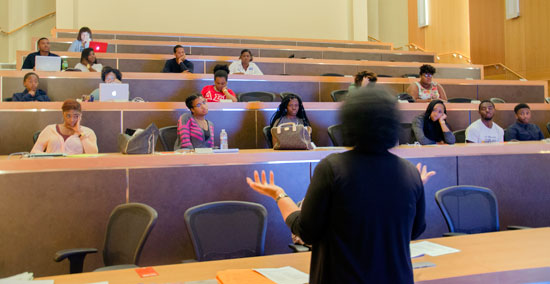- Posted in All University
- Category: Campus News
Student Leaders Learn Suicide Prevention Methods
Lincoln University, Pa. – Students learned the steps that could help save a life from suicide at a recent Counseling Services-sponsored training at the Wellness Center.

Rachel Manson, director of Counseling Services at Lincoln University, addresses students in attendance at the QPR training on September 20, 2016, at the Wellness Center on the Lincoln University campus in Pennsylvania.
Lincoln students learned QPR — Question, Persuade, and Refer — in a 90-minute course designed to help attendees recognize the warning signs of suicide and learn how to offer hope and get help with the goal of saving a life.
In addition to the September 20 session, Lincoln has offered several trainings this month in acknowledgement of World Suicide Awareness Day, which was September 10.
Rachel Manson, director of Counseling Services, said she made the decision to teach QPR in 2011 and has since taught it 14 times on campus. Manson is a certified QPR trainer with experience presenting to diverse populations of students, faculty, staff, and others. As a community outreach effort of Lincoln University Women’s Center, she also conducts this training at the Chester County prison for women, twice a year.
While QPR is one tool, many of Lincoln’s student leaders are also certified in CPR, which is like QPR in that they are both emergency interventions, according to the QPR Institute website. CPR — short for cardiopulmonary resuscitation — is an emergency medical intervention designed to stabilize people who aren’t breathing and who may be in cardiac arrest until the person can reach a hospital. Similarly, QPR is an emergency mental health intervention for those who are suicidal. The sooner warning signs are detected and help sought, the better the outcome of a suicidal crisis will be.
Manson said QPR is widely used by many universities and colleges and is nationally recognized by the Joint Commission on Accreditation of Health Care Organizations as a "best practices" program.

Rachel Manson, director of Counseling Services at Lincoln University, addresses students in attendance at the QPR training on September 20, 2016, at the Wellness Center on the Lincoln University campus in Pennsylvania.
“Suicide is the second leading cause of death among college and university students, but it is also one of the most preventable causes of death,” Manson said.
Manson said that a QPR session taught by a certified trainer specifically for campus groups can also be arranged through Counseling Services at a mutually convenient time.
The training on September 20 targeted student leaders involved in organizations through the Office of Student Life and Development but was open to all students. A QPR training on September 28 targeted Lincoln’s 60 resident assistants and 10 resident hall coordinators.
“The goal is to protect the pride of the campus community,” said Dr. Lenetta Lee, dean of students.
“Thus, it's imperative that resident advisors and residence hall coordinators are trained in QPR. Early recognition of suicide warning signs is significant to the gatekeepers who reside with the students.”
QPR is just one of several ways Lincoln keeps the safety of students a priority. Resident advisors, who play an important role in students’ lives while staying on campus, get training from the Student Conduct Hearing Board regarding the protocol and process when a student violates the student code of conduct and hearings as well as how to ask appropriate questions during hearing. Resident advisors also learn effective ways to communicate with parents.
Article and photos by Shelley Mix, Office of Communications & Public Relations